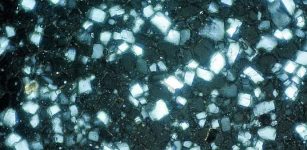Planet’s Turbulent Past And Where Oceans Came From – New Study
Eddie Gonzales Jr. – MessageToEagle.com – The origin of water on our planet is a hot question: Water has immense implications for plate tectonics, climate, the origin of life on Earth, and potential habitability of other Earth-like planets.
Earth. Image credit: Pixabay
In a recent study in Physical Review Letters, a Skoltech professor and his Chinese colleagues suggest a chemical compound that—although now extinct—could have preserved water deep underground in the violent era when massive collisions must have evaporated the Earth’s surface water.
Besides being the all-important substance for the origin of life as we know it, surface water is important for stabilizing a planet’s climate over long periods of time, allowing evolution to happen. Even small amounts of water deep below the surface are known to dramatically increase rock plasticity, which is essential for plate tectonics—a process that shapes the continents and oceans, and drives earthquakes and volcanism. But despite its huge importance for the evolution of rocky planets like ours, we don’t know where the Earth’s water originated.
“Some scientists thought our water was seeded by comets, but this source seems to be very limited—the isotope composition of water in comets is quite different from that on Earth,” says Professor Artem R. Oganov of Skoltech, who co-authored the study.
If the water did not come from above, it must have come from below, from deep within the mantle or even the core of the Earth. But how could it survive the violent first 30 million years or so in the Earth’s history, when the planet was very hot and was ceaselessly bombarded by asteroids and even underwent a catastrophic collision with a Mars-sized planet? These processes must have evaporated part of the Earth and what remained was molten at least several hundred kilometers down, removing the water. Until now, scientists did not know a stable compound that could lock up hydrogen and oxygen atoms within the planet’s interior long enough and then release them as water.
Oganov teamed up with a group of scientists lead by Professor Xiao Dong of Nankai University, China, and together they used Oganov’s crystal structure prediction method USPEX to discover a compound that fits the bill: magnesium hydrosilicate, with the formula Mg2SiO5H2, which is over 11% water by weight and is stable at pressures of more than 2 million atmospheres and at extremely high temperatures. Such pressures exist in the Earth’s core. But everyone knows the core is a metal ball—mostly iron—so the elements making up magnesium hydrosilicate are simply not available there, right?
“Wrong. There was no core at the time. In the beginning of its existence, the Earth had a more or less evenly distributed composition, and it took the iron roughly 30 million years from when the planet formed to seep down to its center, pushing the silicates up into what we now call the mantle,” Oganov explains.
This means that for 30 million years, part of the Earth’s water was safely stored away in the form of hydrosilicates at the depths of the present-day core. During that time the Earth withstood the heaviest phase of asteroid bombardment. By the time the core formed, the hydrosilicates had been pushed into lower-pressure areas, where they became unstable and decomposed. This produced the magnesium oxide and magnesium silicate that make up the mantle today, and water, which started on its 100-million-year-long journey to the surface.
“In the meantime, the Earth was being pummeled by asteroids and even a protoplanet, but water was safe, because it had not yet made its way to the surface,” Oganov adds.
The researchers say their study shows how faulty human intuitions can sometimes be. Nobody had thought about silicates at core pressures, because the constituent atoms were supposedly not to be found there. And even then, people would not have expected a hydrosilicate to be stable at core conditions, because the extreme temperatures and pressures were believed to “squeeze” the water out of the mineral. Yet accurate modeling based on quantum mechanics proved otherwise.
“It’s also a story about how a material that existed for a brief moment on the planetary timescale had a massive impact on the Earth’s evolution,” the materials scientist goes on. “This runs counter to the usual geological mindset, but come to think of it, an evolutionary biologist, for whom much of what we see today has evolved out of now-extinct species, would hardly be surprised, would they?”
The new hypothesis of water origin has implications for other celestial bodies, too.
“Mars, for example, is too small to produce pressures necessary to stabilize magnesium hydrosilicate,” Oganov says. “This explains why it is so dry and means that whatever water exists on Mars, it likely came from comets.”
Or else, consider planets outside our solar system.
“To be habitable, an exoplanet has to have a stable climate, which requires both continents and oceans. So there has to be water, but not too much,” adds Xiao Dong. “There was an estimate that for an Earth-like planet of any size to be habitable, it should have no more than 0.2% water by weight. Our results imply that for large Earth-like planets, called ‘super-Earths,’ the story is likely different: In such planets, pressures stabilizing the magnesium hydrosilicate must exist even outside the core, locking up large amounts of water indefinitely. As a result, super-Earths can have a much greater water content and still support the existence of exposed continents.”
It even has implications for a planet’s magnetosphere.
“At temperatures of more than 2,000 degrees Celsius, magnesium hydrosilicate will conduct electricity, with hydrogen protons serving as charge carriers. This means that our hydrosilicate will contribute to the magnetic fields of super-Earths,” Oganov explains, adding that the list of consequences of the new hypothesis goes on and on.
Written by Eddie Gonzales Jr. – MessageToEagle.com Staff











